Lucerne is more than just picturesque; it’s a tranquil, charming gem waiting to be discovered. This city harmoniously blends nature and urban life, offering an array of activities to enjoy. With its two local mountains, medieval houses adorned with frescoes, ancient wooden bridges, historic old towns, world-class museums, captivating art galleries, and iconic monuments, Lucerne exudes an undeniable enchantment. Whether you opt for a scenic hike up Mount Rigi or ascend Mount Pilatus for unrivaled vistas, Lucerne ranks among Switzerland’s most captivating cities, promising an unforgettable visit.
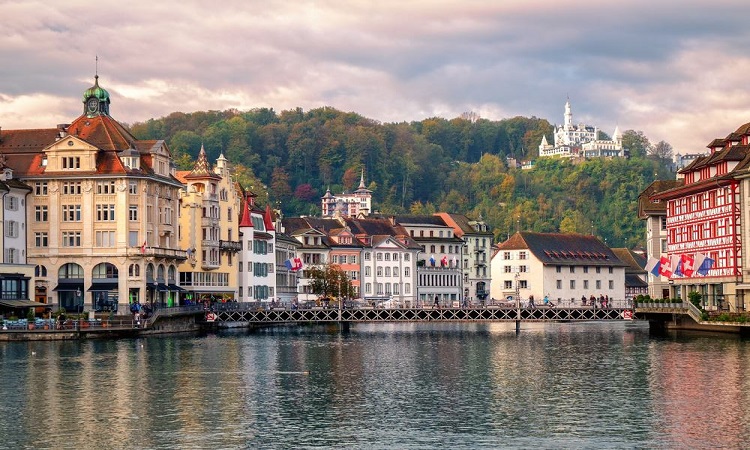
Lucerne Old Town-New York Jewish Travel Guide
A Brief Overview of Lucerne’s Jewish History
The presence of Jews in Lucerne dates to the year 1300, spanning various eras and residing under different cantonal and regional authorities. It was in 1800 that the Lucerne Orthodox Jewish Community was established, acquiring legal recognition. In 1870, the formal Jewish community in Lucerne and the surrounding regions was established, marking a significant milestone.
Initially, in 1892, the Jewish Community of Lucerne, known as JGL, consisted of only a handful of Jewish families from diverse backgrounds. Together, they undertook the responsibility of overseeing various aspects of the community’s life. This included the maintenance of the synagogue, the Mikveh (ritual bath), a Jewish school, and a Jewish kindergarten. Additionally, they supported the local chazzan (cantor) and choir, provided interest-free loans, practiced Tzedakah (charitable giving), aided those in need and refugees, and managed both the old and new cemeteries.
Over time, JGL experienced growth and transformation. In the aftermath of two world wars, Lucerne witnessed an influx of Jewish families immigrating to Switzerland from other European nations. Furthermore, Holocaust survivors sought refuge in Switzerland, particularly in the city of Lucerne, contributing to the evolution and resilience of the Jewish community in this historic Swiss city.
Lucerne’s Synagogue and Thriving Community
Lucerne’s Jewish community is a vibrant hub of activity, offering a wide array of essential services and enriching experiences. Here’s a glimpse of what the community provides: Synagogue, Educational Program (Shiurim), Mikveh, Jewish Cemetery, Chevra Kadisha, Women’s Organization, Visiting Ill, and the Shabbat and holiday celebrations.
These services and activities not only strengthen our religious and cultural foundation but also enhance the overall well-being and unity of Lucerne’s Jewish community.

Meir Shetrit, President of the Lucerne Synagogue: New York Jewish Travel Guide
Meir Shetrit, the esteemed president of the Lucerne Synagogue, shared with NYJTG the remarkable history of this cherished institution. Dating back to 1912, the synagogue owes much of its existence to the remarkable generosity of Mr. Joseph Croner, a traveler who visited Lucerne at the turn of the century and made a significant contribution to help this beautiful synagogue come to life after being moved by the warmth and vitality of the neighborhood.
The Lucerne Synagogue stands as a true gem, not only in Switzerland but throughout Europe. Within its hallowed walls, more than 200 seats await both men and women. What sets this synagogue apart is its preservation of a unique architectural style that dates back a century. It’s a living testament to the passage of time and the enduring spirit of this place of worship.
As of 2023, Mr. Shetrit and his wife have chosen Lucerne as their permanent residence. He wears many hats, serving not only as an educator but also as an attorney, sharing his wisdom through lectures on Judaism and religion. Mr. Shetrit proudly points out that nearly everything you see within the synagogue is original, with only minor changes made to the carpet, lighting, and painting. This commitment to preserving the synagogue’s heritage underscores its historical significance and cultural richness.
Mr. Shetrit offers a fascinating glimpse into the diverse composition of the Lucerne Jewish community, which he aptly describes as a “mixed community” encompassing a wide spectrum of religious observance, from Hasidim to Haredim and everything in between.
The shadow of the Holocaust cast a poignant impact on the community’s demographics, resulting in a decline in population. Many families, seeking refuge and opportunities, embarked on journeys to destinations such as England, Israel, or Zurich. As of the present day, the community comprises approximately 50 Jewish families. Most of these families do not identify as strictly religious and hail from Swiss, Israeli, or mixed backgrounds, reflecting the multicultural tapestry of the region.
To support the synagogue’s daily services and Shabbat observance, the Yeshiva of Lucerne plays a crucial role, offering the necessary minyanim (prayer quorums). This Yeshiva hosts around 14 full-time students from Israel and America, alongside the rabbi residing in Saint Louis, France.
Within the synagogue, there are kosher mikvehs available for both women and men, as well as separate mikvehs designated for the ritual immersion of dishes, ensuring the observance of Jewish dietary laws.
While Lucerne may not have dedicated kosher restaurants, the nearby Yeshiva accommodates those seeking kosher meals, fostering a sense of community and sustenance for adherents of Jewish dietary restrictions. Mr. Shetrit also mentions the Passover seder, a cherished tradition that draws 20 to 25 guests. Anticipating an even larger turnout for the second half of the holiday, the Lucerne Jewish community continues to embrace its customs and heritage with open arms.

Synagogue of Lucerne- New York Jewish Travel Guide
The historical significance of the Lucerne Synagogue is underscored by a distinctive tradition related to Brit Milah (circumcision). In 1860, the practice of performing Brit Milah was banned. However, the synagogue has preserved a unique and fascinating custom involving special candles that play a pivotal role in the ceremony. The lighting of these candles served as a signal to the congregation, signifying that the Brit Milah was about to take place within the synagogue. Even today, Lucerne continues to uphold this cherished tradition by lighting these exceptional candles.
Lucerne: WHAT TO SEE
Old Town
Exploring the labyrinthine alleys and meandering streets on the northern side of the city is an absolute must while in Lucerne. The old town exudes a timeless charm, thanks to its impeccably preserved historical architecture. Strolling through these streets is akin to a journey back in time. Each street in the old town boasts a picturesque scene, adorned with an abundance of half-timbered and traditional Alpine-style houses. At every turn, you’ll stumble upon quaint mom-and-pop shops, one-of-a-kind eateries, and hidden gems waiting to be discovered.
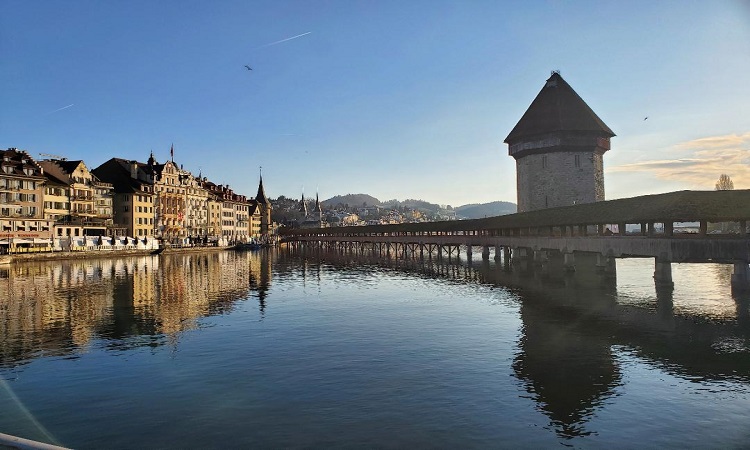
Lucerne Old Town-New York Jewish Travel Guide
Town Hall on Kornmarkt: A Cultural Gem
The Town Hall on Kornmarkt stands as one of Switzerland’s most splendid public buildings, rightfully designated as a cultural monument. Its Renaissance architecture is a sight to behold, and its stunning location is equally impressive. Situated gracefully alongside the banks of the river Reuss in the heart of the Old Town, this majestic edifice forms the centerpiece of a vibrant area that beckons tourists with an array of attractions, whether in the radiant light of day or the enchanting evening hours.
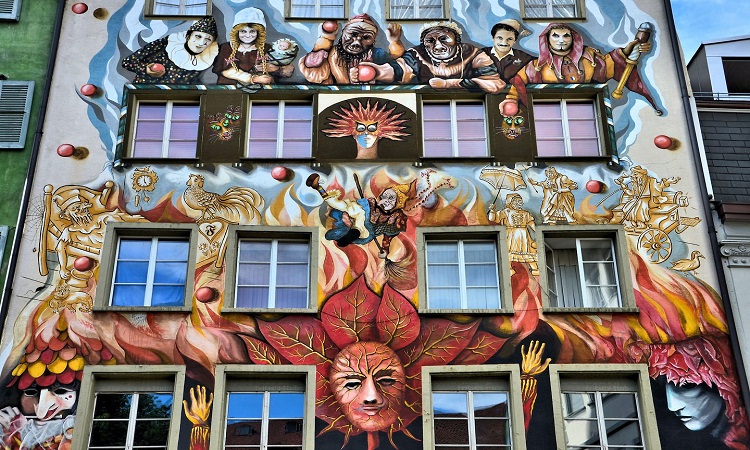
Carnival Mural by Robert Ottiger in Lucerne, Switzerland-New York Jewish Travel Guide
Embark on the Mount Rigi Cog Railway Adventure.
A journey on the cog railway to the summit of Mount Rigi often hailed as the “Queen of the Mountains,” is an iconic Swiss experience that should not be missed. This remarkable railway ascends to an elevation of 1,798 meters from the serene shores of Lake Lucerne, offering breathtaking vistas along the way. It’s worth noting that this cog railway, Europe’s oldest, has been in operation since its inception in 1871.
Caroline Pfyl, the representative of Rigi Bahnen, enthusiastically highlights the allure of this incredible journey, stating, “From the summit, visitors are treated to an unparalleled 360-degree panoramic spectacle. Here, you can feast your eyes on the stunning views of the lakes, majestic mountain ranges, the enchanting German Black Forest, and a captivating array of alpine flora.” Riding the Mount Rigi cog railway promises not only a scenic adventure but also a profound connection with the natural beauty of Switzerland’s landscape.
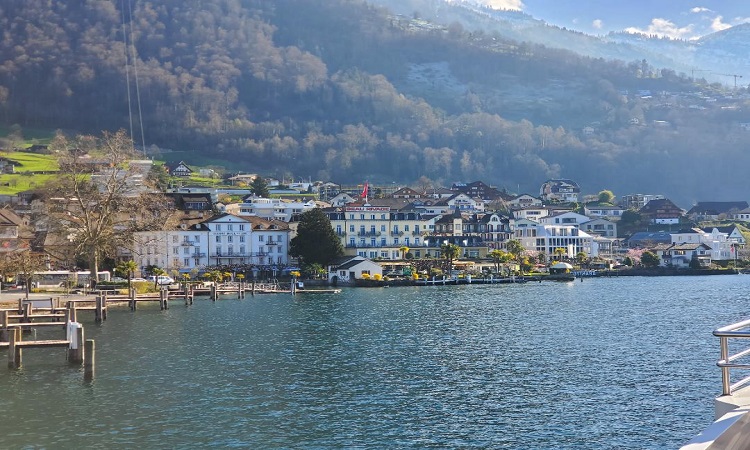
Cruise from Lucerne to Vitznau-New York Jewish Travel Guide
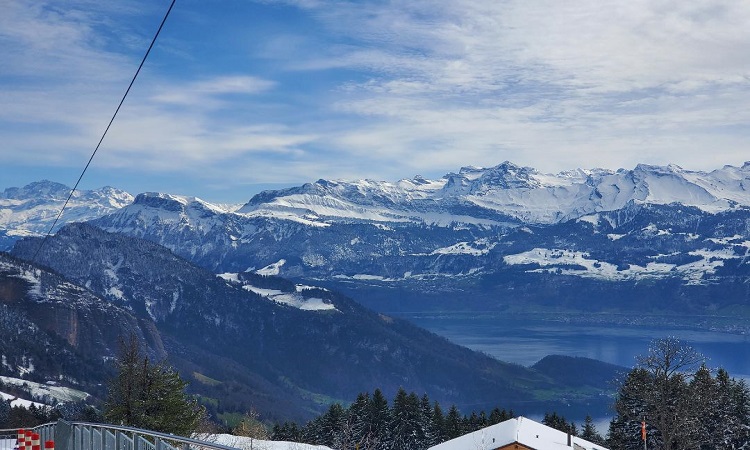
Views of the Swiss Alps from Mount Rigi-New York Jewish Travel Guide
Fritschi Fountain (Fritschibrunnen) at Kapellplatz: A Refreshing Oasis
Lucerne boasts an impressive array of over 200 fountains, diligently providing its residents and visitors with pristine drinking water of the highest quality. According to Ursula Leu, a knowledgeable tour guide, “The metropolitan area boasts more than 200 fountains, with 166 of them accessible to the public.” What’s remarkable is that these fountains undergo regular inspections and are cleaned using ultraviolet rays to ensure germ-free water. The source of this pure water lies in the lake nestled at the base of Mount Pilatus.
Among these fountains, the 100-year-old Fritschi Fountain stands out as one of the most beloved. Its enduring popularity makes it a must-see attraction for those exploring the city.
Chapel Bridge: Europe’s Oldest Covered Bridge
Lucerne proudly houses the Chapel Bridge (Kapellbrücke), a historical marvel and Europe’s oldest covered bridge. With its impressive length of 200 meters, this bridge, dating back to the 14th century, was originally built as part of the city’s fortifications. In 1993, a fire nearly devastated this wooden structure, making its restoration more remarkable.
What sets the Chapel Bridge apart are its 17th-century ceiling panels, adorned with vivid depictions of Switzerland’s and Lucerne’s historical narratives. Beyond its architectural significance, the bridge has served various roles throughout history, including as a jail, a place of torture, a municipal archive, and a local treasury. Today, it stands as a symbol of resilience and a cherished photographic destination, enchanting visitors with its timeless charm and historical resonance.
To plan a trip to Switzerland, contact Switzerland Tourism or go to https://www.myswitzerland.com/en-us/.
To make a hotel reservation, email MAIL@WILDEN-MANN.CH or go to https://www.wilden-mann.ch/.
Fly Swiss: https://www.swiss.com/us/en/homepage.
Visit the Swiss Travel System at https://www.mystsnet.com/en/.
Story by Meyer Harroch, New York Jewish Travel Guide, and New York Jewish Guide.com
The author took part in a press trip sponsored by Switzerland Tourism.



You must be logged in to post a comment Login